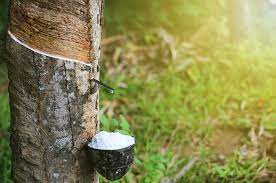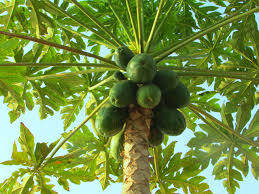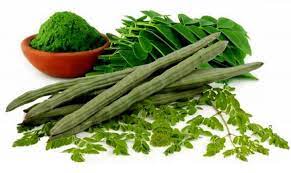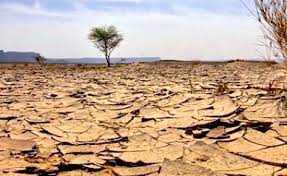
Natural rubber refers to an elastic material derived from the latex sap of trees, particularly trees belonging to the Hevea and Ficus genera. It is either an elastic hydrocarbon polymer or an elastomer. Natural rubber is among the kinds of rubber that further includes vulcanised rubber that is processed into a wide range of rubber items. It is also known as India rubber, gum elastic, or caoutchouc.
Although there are thousands of lactiferous (latex vessel bearing) species in the plant kingdom, only about two thousand, five hundred (2,500) species contain rubber in their latex. Among those, only around five hundred (500) were tried as a source of natural rubber. The Para rubber tree or Hevea brasiliensis of the family Euphorbiaceae is the largest source of commercial natural rubber, amounting to almost ninety-nine percent (99%) of the natural rubber production in the world.
Latex, of which rubber is a constituent, is synthesized and contained in specialized tissues called laticifers. Latex is present in almost all parts of the plant, but for the purpose of commercial exploitation it is harvested from the latex vessels concentrated in the bark in the proximity of vascular cambium. The process of careful extraction of latex through controlled wounding on the bark is called rubber tapping.
As a product from varieties chosen by our Group’s research department, productive and tolerant to wind and diseases, natural rubber is a renewable raw material with many advantages. Rubber trees are a significant carbon sink as well.
Rubber trees are a flowering plant that belong to the family Euphorbiaceae (spurge). It is the most economically important member of the genus Hevea.
Natural rubber results from the coagulation of the latex from the rubber tree. This latex, not to be confused with the sap, flows in a separate network of specialized vessels in the bark of the tree: the lactiferous vessels. Natural rubber is obtained from the first latex transformation or coagulated cup lumps in the field and does not contain any solvents.
Rubber is native to South America. Its cultivation has spread to all tropical regions, more specifically to Southeast Asia as well as West and Central Africa. The history of natural rubber production in Nigeria began in 1894 with the exploitation of Funtumia elastic, indigenous wild rubber. Rubber is grown in Edo, Delta, Ondo, Ogun, Abia, Anambra, Akwa Ibom, Cross River, Rivers, Ebonyi, and Bayelsa States where the amount of rainfall is between one thousand, eight hundred (1,800) mm and two thousand (2,000) mm per annum.
Since the mid-twentieth century, all plantations have used selected plant material obtained through grafting. Rootstocks are raised in nurseries for six months before receiving a graft. These small rubber trees are then transplanted into the field, with a density of about five hundred to five hundred and fifty (500 to 550) trees per hectare.
After six years, they reach physiological maturity and the vegetative stage allowing for the start of tapping, through a fine incision in the bark to extract the latex. The rubber tree has a lifecycle of almost thirty (30) years: when the trees’ yield decreases, the timber can be used for furniture, pulp or even firewood, or else it can be left in the field to decay naturally and maintain a good level of organic matter in the soil.
Harvesting starts with a fine incision in the bark of the tree. This operation makes it possible to transect the lactiferous vessels, allowing the latex to flow. It is harvested into cups placed below the tapping notch. Generally, tapping is done every four (4) days, and the latex in the lactiferous vessels is renewed after harvesting.
Rubber is harvested in a liquid state – latex – or after coagulation in the field (cup lumps) and is then taken to the rubber factory. At the factory, the cup lumps are stored in bunkers for several weeks before processing. Then this raw material is washed, mixed, granulated and dried several times before being pressed into thirty (35) kilogramme bales. Strict adherence to quality standards throughout processing ensures compliance with end-users’ requirements. The finished product is then labeled “Technical Specified Natural Rubber” (TSNR) globally or NOKO10 in Nigeria.
Natural rubber is desired for its physical properties:
Low thermal conductivity
Elasticity
Impact resistance
Vibration and noise damping qualities
The global natural rubber market demand reached a value of USD 30.61 billion in 2022 and is expected to grow at a compound annual growth rate (CAGR) of three point five percent (3.5%) in the forecast period of 2023-2028, reaching a value of about USD 37.63 billion in 2028.
Significant growth in the automotive industry across the globe is one of the key factors creating a positive outlook for the market. Natural rubber is widely used for manufacturing premium-quality tires, seat belts, brake hoses, airbags, floor mats, bumpers and dust covers for enhanced performance, durability and reliability.
Moreover, the widespread product utilization to produce casual, formal and protective footwear for adults and children with enhanced slip resistance, design flexibility and durability is providing a thrust to the market growth.
In line with this, the increasing preference for rubber-based surgical supplies, respirators and pacemakers is also contributing to the growth of the market.
Additionally, the increasing utilization of sustainable technologies for sourcing natural rubber with zero or minimal deforestation and wastage of resources is also favoring the growth of the market. Other factors, including rapid industrialization, especially in the emerging economies, along with the increasing expenditure capacities of the consumers, are anticipated to drive the market toward growth.
Based on type, the market is segmented into:
RSS Grade
Latex Concentrate
Solid Block Rubber
Others
On the basis of application, the market is categorised into:
Tyres and Related Products
Latex Products
Footwear
Non-Automotive
Engineering
Belting and Hose
Others
Natural rubber is a vital agricultural commodity in Nigeria and natural rubber production in Nigeria was about fifty-three thousand (53,000) tons in 2017. Tyre production facilities were closed-down and local consumption of natural rubber is confined to footwear sector now.
Nigeria has comparative advantage in the cultivation and processing of natural rubber and it would create employment, earn taxes for government and earn scare foreign exchange.






















